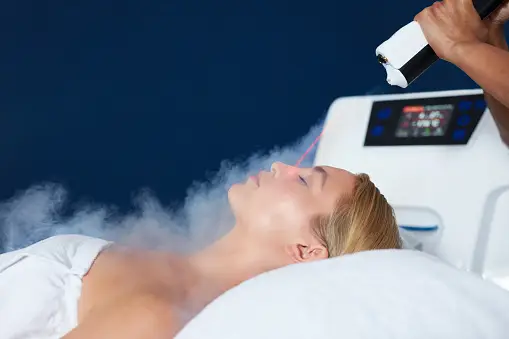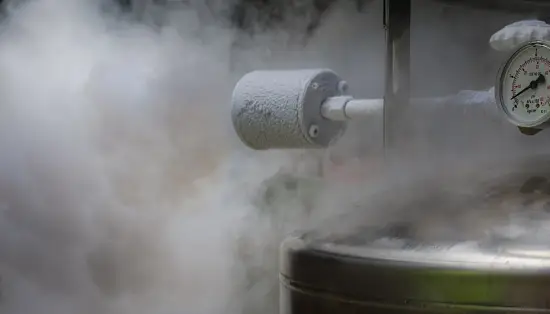After undergoing cryotherapy, the skin typically goes through a process of healing and regeneration. Cryotherapy involves freezing the targeted area of the skin to remove unwanted tissue, such as warts or other skin lesions. The frozen tissue eventually dies off and is naturally shed as the skin heals. Here’s what you can generally expect:
- Initial Redness and Swelling: After cryotherapy, the treated area of the skin may appear red, swollen, and inflamed. This is a normal response to the freezing process and should subside over a few days.
- Blister Formation: Blisters can form within hours to a day after the procedure. These blisters are often filled with fluid and might be uncomfortable. It’s important not to pop these blisters, as they protect the healing skin beneath.
- Skin Peeling: As the blistered skin heals, it may start to peel away. This is a natural part of the healing process, and you shouldn’t forcefully peel the skin off. Allow the peeling to happen on its own to avoid causing any damage.
- Temporary Color Changes: The treated area might also go through color changes, such as becoming darker or lighter than the surrounding skin. These color changes are usually temporary and tend to normalize over time.
- Complete Healing: The skin will gradually heal over a period of several weeks. During this time, you may notice that the treated area becomes smoother and returns to a more normal appearance. Keep in mind that the timeline for healing can vary depending on the size of the treated area, the individual’s skin type, and how well they care for the healing skin.
- Possible Scarring: In some cases, cryotherapy can lead to scarring, especially if the treated area was large or the healing process didn’t go smoothly. Proper wound care and following your healthcare provider’s instructions can help minimize the risk of scarring.
- Follow-up: Your healthcare provider might schedule follow-up appointments to monitor the healing progress and make sure there are no complications.
It’s important to follow the aftercare instructions provided by your healthcare provider to ensure proper healing and minimize the risk of complications. If you have any concerns about the healing process or experience unusual symptoms, it’s recommended to reach out to your healthcare provider for guidance. Keep in mind that individual experiences can vary, so discussing your specific situation with a medical professional is always advisable.
What should skin look like after cryotherapy?
After cryotherapy, the skin may go through a few stages, and its appearance can vary depending on the type of cryotherapy treatment (e.g., localized treatment or whole-body cryotherapy). Here’s a general idea of what to expect:
-
Immediately after treatment:
- The skin might appear red or flushed due to increased blood flow, but this typically subsides within a few minutes to an hour.
- You may feel a cooling or tingling sensation that can last for a short period after the treatment.
-
24-48 hours after treatment:
- Mild swelling, redness, or a slight raised appearance could occur around the treated area.
- If it was a more intense cryotherapy treatment (like for warts or other skin conditions), you might notice some skin irritation or blistering in the treated area.
-
A few days after treatment:
- Any swelling or redness should gradually fade.
- If there was any blistering or scabbing, it should heal in a few days to a week, depending on the treatment’s intensity.
If the skin looks excessively red, blistered, or if pain persists longer than expected, it’s a good idea to consult with a healthcare professional to ensure there are no complications.

What happens to skin after cryotherapy?
After undergoing cryotherapy, which involves exposing the skin to extremely cold temperatures to treat various skin conditions, the skin goes through a series of changes as part of the healing process. Here’s a more detailed breakdown of what happens to the skin after cryotherapy:
- Initial Reaction: Right after the cryotherapy treatment, the skin will react to the extreme cold by constricting blood vessels. This can lead to a pale appearance in the treated area due to reduced blood flow.
- Inflammation and Redness: In the hours following the treatment, the skin will likely become red and inflamed. This is a normal response to the freezing and is a result of increased blood flow and immune cell activity in the area. Inflammation is the body’s natural way of healing.
- Blisters Form: Within 24 hours after the treatment, small blisters may develop on the treated skin. These blisters are filled with fluid and are a sign that the top layer of skin has been damaged by the freezing process. Blisters may be uncomfortable but should not be intentionally punctured.
- Blister Rupture and Peeling: The blisters may eventually rupture or be absorbed by the body. As this happens, the top layer of damaged skin will start to peel away. It’s essential not to forcibly peel or remove the skin, as this could lead to infection and delayed healing.
- Formation of New Skin: Underneath the peeled skin, new skin cells will begin to grow and migrate to the surface. This is part of the body’s natural wound-healing process. The skin might appear pink or sensitive during this phase.
- Skin Healing and Color Changes: Over the course of several weeks, the new skin cells will continue to mature and develop. The color of the treated area may gradually normalize, although it’s possible for the area to remain slightly lighter or darker than the surrounding skin for some time.
- Possible Itching and Discomfort: As the skin heals, you might experience itching and mild discomfort. This is a common part of the healing process and can be managed with over-the-counter creams or ointments recommended by your healthcare provider.
- Scar Formation (Possible): Depending on factors like the size of the treated area, the depth of the freezing, and your skin’s natural healing tendencies, there is a risk of scar formation. Proper wound care and following your healthcare provider’s instructions can help minimize this risk.
- Follow-up and Monitoring: In some cases, you might need to schedule follow-up appointments with your healthcare provider to monitor the healing progress and address any concerns.
It’s important to note that individual responses to cryotherapy can vary, and these stages might not occur in the same way for everyone. Proper aftercare, including keeping the treated area clean, moisturized, and protected from the sun, is essential for optimal healing and minimizing complications. If you have any questions or concerns about your specific situation, it’s best to consult with a healthcare professional who can provide personalized guidance.
How long does skin stay pink after cryotherapy?
The duration for which the skin remains pink after cryotherapy can vary widely from person to person and depends on factors such as the individual’s skin type, the size and depth of the treated area, and how well they follow aftercare instructions. In general, the pink or reddish color of the treated skin can last for a few weeks to a few months. Here’s a general timeline:
- Immediate Reaction: Right after the cryotherapy treatment, the skin will likely appear red or pink due to increased blood flow and inflammation. This immediate redness usually subsides within a few hours to a day.
- Early Healing Stage: In the days following the treatment, the pink color may persist as the body’s healing processes continue. The treated area might be slightly swollen or sensitive during this time.
- First Few Weeks: Over the course of the first few weeks, the pink color of the treated skin may gradually fade. New skin cells are forming and migrating to the surface to replace the damaged skin, which contributes to the normalization of skin color.
- Continued Healing: In the following weeks, the pinkness of the treated skin should continue to improve. However, some degree of pink or light discoloration might persist for a while longer.
- Several Months: For some individuals, it might take a few months for the treated area to fully regain its natural color and blend in with the surrounding skin. During this time, it’s important to protect the healing skin from excessive sun exposure, as UV radiation can slow down the healing process and contribute to color irregularities.
It’s worth noting that some degree of color variation between the treated area and the surrounding skin may persist even after the initial healing period. This is often more noticeable in individuals with darker skin tones.
If you’re concerned about the duration of the pink coloration after cryotherapy, it’s best to consult with the healthcare professional who performed the procedure or your dermatologist. They can provide personalized guidance based on your specific situation and recommend appropriate aftercare to support the healing process and minimize any lingering color changes.
